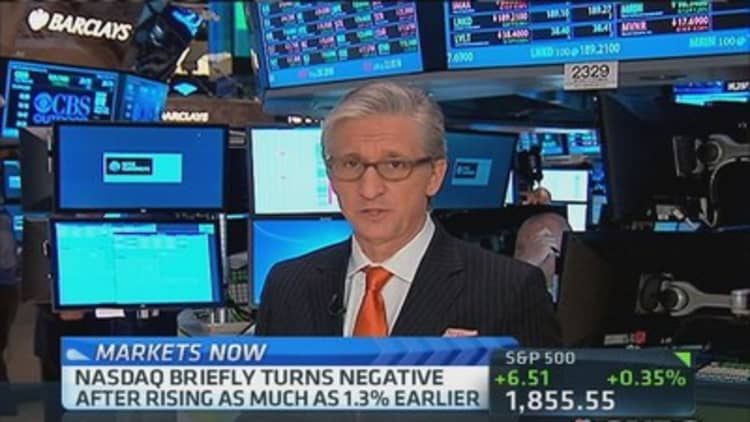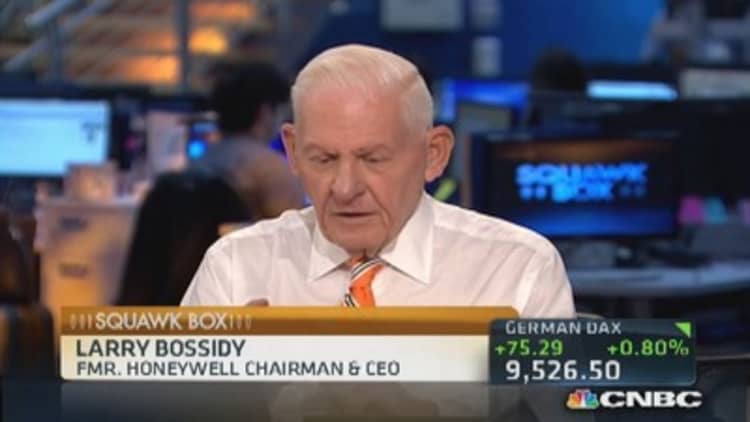
U.S. stocks trimmed their gains Friday afternoon, with the S&P 500 down for a second week in three, as investors positioned for the end of the quarter on Monday.
"The last two trading days of the quarter, people are looking to take some profit. It's a similar pattern to what we've seen in some of these momentum stocks the last couple of days. The market is telling us you should expect more volatility today and Monday. People are trying to figure out which sectors to be in the next quarter, and what things do I need to be lightening up on," said JJ Kinahan, chief strategist at TD Ameritrade.
"When the market is trading in such a tight range, and the S&P 500 has been in a 40-point range for six weeks, people get trigger happy," Kinahan said.
"It has been a range-bound start for the year, 1,840 to 1,880 is the range we've been in for a while. But that makes sense, given the economic economic data that has come out, which has been mixed," said Jerry Villella, an investment specialist at JP Morgan Private Bank.
Data on Thursday had weekly jobless claims falling, indicating "200,000-plus payroll jobs going forward," said Villella of the monthly nonfarm payrolls report, with the March data coming next Friday.
If that trend persists, "we could see a five percent unemployment rate by mid-to-late 2015," he added.
Wall Street had rallied, with the Dow Jones Industrial Average jumping 150 points, on data that had U.S. consumer spending rising and signals from Europe and China prompted thoughts of stimulus from overseas.
"We've seen a bunch of days this week when the market opens up a lot in the morning and then doesn't follow through. Plus, with two days left in the quarter, I'm sure there is a lot of noise related to that. It could be another typical buy-on-the-dip attempt, we'll see by day's end," said Peter Boockvar, chief market analyst at the Lindsey Group.
Shares of Tesla Motors jumped after the National Highway Traffic Safety Administration said it had closed its investigation into fire accidents of the electric-car maker's Model S vehicles, but the agency added its move did not mean it had found a safety-related defect did not exist. General Motors halted sales of 1.4 liter Chevy Cruze models on Friday, but no reason was given. Shares of the car manufacturer climbed.
Tesla and other momentum stocks including Priceline.com climbed Friday after getting slammed in recent days, along with social media company Twitter.
J.P. Morgan on Friday revised its estimate of real annualized GDP growth in the first quarter from 2 percent to 1.5 percent, while leaving its projection for the second quarter unchanged at 2.5 percent.
"The durable goods report this week was surprisingly weak," said Villella of one of the drivers behind his bank's downward revision. Still, "domestic growth for the year will be 2.5 percent and global economic growth will be about 3.5 percent," he said of J.P. Morgan's 2014 outlook.
The year will be "much more volatile than last year, when we had remarkably low volatility. The average peak to trough decline is typically 14 to 15 percent, we didn't see it last year. Seven percent to 9 percent equity returns are what we expect this year," Villella added.
Major U.S. Indexes
Rising 0.1 percent on the week, the Dow rose 58.83 points, or 0.4 percent, to 16,323.06, with Microsoft pacing gains that included 26 of its 30 components.
Down 0.5 percent from the week-earlier close, the advanced 8.58 points, or 0.5 percent, to 1,857.62, with energy and consumer discretionary rising the most and health care and telecommunications hardest hit among its 10 major industry groups.
After wavering between gains and losses, the Nasdaq Composite climbed 4.53 points, or 0.1 percent, to 4,155.76, leaving it down 2.8 percent from the prior Friday's close.
For every share falling, more than two gained on the New York Stock Exchange, where 639 million shares traded. Composite volume approached 3 billion.

A report Friday had consumer spending rising 0.3 percent in February after climbing by a revised 0.2 percent in January. Income rose 0.3 percent last month after rising by the same margin in January.
Another report Friday from the Thomson Reuters/University of Michigan index found consumer sentiment hit 80 in March, just below an 80.5 estimate.
In a speech reported by state media on Friday, China's premier indicated the Beijing government was prepared to take action to bolster the world's second biggest economy, saying the government would gradually roll out targeted measures to help economic activity.
And on Wednesday, Germany's Bundesbank said the ECB could buy loans and other assets from banks to support the euro-zone economy, with the statement marking a dramatic departure from its previous stance on the policy.
"The ECB (European Central Bank) and potentially China may be ramping up their stimulus. There is talk of potential easing and stimulus in China, and the consumer spending data was pretty good, so putting it all together, there is good news here at home and possibly of the Fed passing the baton to some other central banks," said Jack Ablin, chief investment officer at BMO Private Bank.
The dollar gained against other currencies, while the 10-year Treasury yield rose 4 basis points to 2.72 percent.
A gradual rise in Treasury yields is to be expected, said Villella at JP Morgan Private Bank.
"If our economy is going to grow 2.5 to 3 percent, it should real real GDP and inflation expectations. But the labor market has been so weak during this recovery and that's partly we we haven't seen any inflation."
On the New York Mercantile Exchange, crude oil rose 39 cents to $101.67 a barrel, up 2.2 percent for the week; gold futures fell 50 cents to $1,294.30 an ounce, down 3.1 percent for the week.
On Thursday, U.S. stocks fell after mixed economic reports cast a favorable light on the labor market while also illustrating the economy expanded less than economists expected at the end of last year.
—By CNBC's Kate Gibson
More From CNBC.com:


